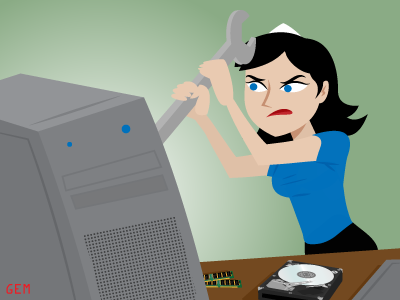-
-
products
-
resources
-
support
-
company
-
A Cheap PC Upgrade that Makes Sense – Tips from Russ Pitts
By Steve Horton November 14, 2011guest blog, pc upgrades, russ pittsNo Comments
Russ Pitts
Last PC hardware upgrade purchased: Happauge Colossus HD video capture card
Ever have a hard drive crash and lose everything? Oh god, yes. Twice. Lost everything, including the draft of a play I’d been writing.
Go-to online store for PC components: Newegg.com
AMD or Intel? Why? I’ve gone back and forth over the years. AMD is always going to be a winner on price, but I’ve found that Intel CPUs usually have a slight-to-moderate edge in performance and stability.
ATI or nVidia? Why? I’ve always had a soft spot for nVidia.
Russ Pitts is the former Editor-in-Chief of escapistmagazine.com and the former head writer and producer of TechTV’s “The Screen Savers.” He has been building and upgrading PCs for over 15 years.
Looking for a cheap PC Upgrade that makes sense?
Be honest: when you talk about upgrading your gaming PC, you’re just trying to justify a new video card purchase. We’ve all seen those sexy vid card ads in the magazines, and we all want them. You’re not a special snowflake in that regard. But new vid cards, for all of their beauty and majesty, usually only give you incrementally faster performance over the older models. Sure, they look sexy and have lots of spins and fins, but they’re really just toys. If you already have a graphics card that’s been minted in the past few years, your upgrade money is better spent on memory.
A new graphics card will boost the speed at which your machine translates software into pretty pictures, but memory is where the rubber meets the road in PCs, and an upgrade to your RAM and hard drives will speed up everything, even graphics processing. Best part? Both RAM and physical memory are cheaper now than they’ve ever been, so the time is right to spend as much money as you can to get the best performance you’re able.
RAM
With RAM, you want as much as your machine will hold. Most PCs can’t access more than 8 gigabytes right now, so that’s the number to beat. If you don’t have at least half that much memory in your machine, stock up, but buy wisely. Overclocked DIMM chips with racing stripes and fins may look sweet, but unless you have a window cut into the side of your box and you carry it with you to LAN party meet-ups, no one is going to care what your RAM looks like (and probably not even then), and the performance gains from the overclocked chips are negligible.
Spend your money instead on buying as much memory as you can afford, but be sure to get a reputable brand. Crucial, Kingston and Corsair are big names for a reason: they make reliable RAM and have been doing so for years. G-Skill also makes a good line of quality, budget-priced RAM aimed at the hardcore tweaker crowd in addition to their overclocked models. I have a set of their base-level, double-sided RAM DIMMs in my machine right now and they run like a champ.
Just like with the tires on your car, it’s best to use the same brand and model of RAM across the board, but if cost concerns force you to mix and match, make sure that you at least run the same brand and type of memory in corresponding slots. Memory likes to run in pairs, and most motherboards have color-coded slots signifying which two go together. If you can’t tell what goes where, consult a manual or a friend.
Hard Drives
For a hard drive upgrade, almost anything newer or bigger than what is currently in your machine will be an upgrade. Even if your current drive is only a few years old, you can’t go wrong with replacing it.
Your hard drive contains some of the very few moving parts in your PC and moving parts wear out, no matter how well they are made. A dying hard drive could be slowing down and subtly reducing performance for years before it shows clear signs of death (the whirring or scratching noises and that horrible whine that means death is imminent).
Besides, everything being made right now is of slightly lower quality than what used to be made. Old people like me say that a lot, but it’s true. I still have hard drives that were top-of-the line when they came out and laughably obsolete only a few years later (13 GB!), but they still run trouble-free (on PCs that can connect to them). These days I’m lucky if a hard drive lasts as long as the programs stored on it.
The tradeoff is in technical whizbangery. Even though they don’t last as long, newer hard drives are more efficient and have bigger caches, allowing them to transmit data more quickly than older models. They’re also bigger, which is always better. Once you upgrade, if your old drive is still kicking, you can use it as an external back-up, using one of the external hot-swap docks like Thermaltake’s Blac-X, or leave it in your PC as a second (or third, or fourth) drive if you have the spare connections.
Check the specs on your current drive and see how big it is and what RPM it spins at and aim for something better. Buy as big as you can so you won’t be kicking yourself when you run out of space. Even if you have a 500 GB or bigger hard drive, invest in something larger now and you won’t regret. If your current hard drive spins at less than 7200 RPM, then you definitely want a faster drive. The faster it spins, the more quickly it can access your data. 7200 RPM is the current price/performance sweet spot, but if you have the cash you can sometimes find a faster drive. It will probably require additional case cooling, but it’s your money.
Go Green
If you’re eco-conscious, one of the “green” drives currently manufactured by Western Digital and Seagate are good deals, and tend to be very large and reasonably fast while keeping power consumption to an Earth-friendly level. You will lose power over a standard drive, and you may also lose some measure of control. The eco-drives like to turn themselves off and throttle their speed according to their programming, not your needs.
I have a WD Green installed right now as a secondary drive in my mini-tower productivity machine. It’s got 1.5 terabytes of space, and I use it mainly for storing documents, archived video footage and other data. There is a noticeable lag when it spins up if I haven’t accessed the disk in a while, but the tradeoff in quiet and coolness is worth it for me for that particular PC. I don’t think I’d recommend it for a gaming rig, but it’s worth mentioning as an option. Gaming rigs tend to be massive power hogs, and with the price of energy skyrocketing, sacrificing that much power for the sake of entertainment may no longer be a justifiable expense for some people. It’s your call.
Illustration: Gordon McAlpin SSDs
If you have the coin, this would also be a good time to look into buying a Solid State Drive (SSD). These are hard drives that store memory like flash drives, but with the capacity of a hard drive, and they have no moving parts to wear out or break. SSD drives are almost ten times more expensive than their rotating counterparts, but the benefit in speed is massive.
This is not an upgrade for the faint of heart, though. Some SSD drives are still unpredictably unstable, and unlike a standard hard drive, if an SSD drive fails, it could take all of your data with it — instantly. If you’re flush with cash and want to go for it, I recommend keeping a standard HD in your machine for your data, and using the SSD for your OS and other programs. Your machine will still access the spinning HD at normal HD speeds, but you will see a spectacular gain in overall performance. Your machine will also run cooler and quieter, which is a bonus.
Since most SSD drives are designed for use in laptops, you’ll need a bracket to mount them into your 3.5″ hard drive bay, or, if you buy your games online and don’t ever use your optical drive, you can jettison it and use the extra space for mounting either your standard-sized hard drive (with the help of a 5.25″ to 3.5″ adapter bracket) or an SSD drive. Not only will this free up some space and probably a SATA connector, but it will also increase airflow, helping keep your PC cooler, which may also help speed things up. Bonus!
Was this post helpful?YesNoFree Driver Updates
Update your drivers in less than 2 minutes to enjoy better PC performance - Free.
Free Driver Updates
Update your drivers in less than 2 minutes to enjoy better
PC performance - Free.
Didn't find your answer?Ask a question to our community of experts from around the world and receive an answer in no time at all.most relevant recent articles Pin It on Pinterest
